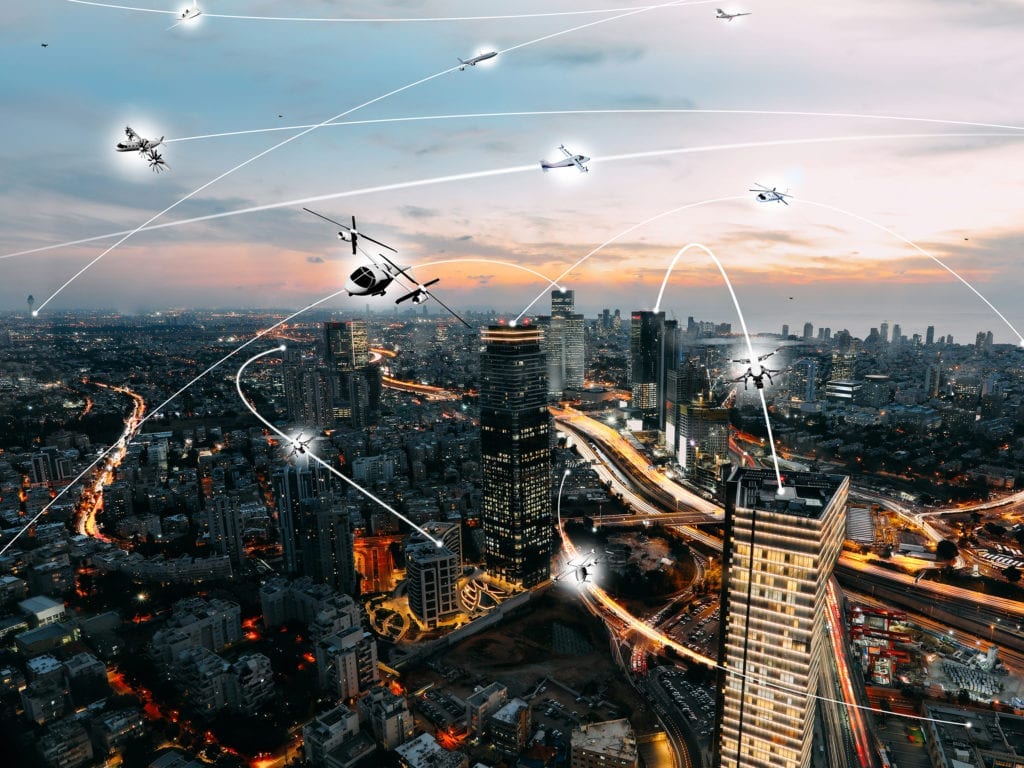
At a three-day workshop hosted by the Vertical Flight Society (VFS) in Washington, D.C., stakeholders in the broader electric vertical takeoff and landing (eVTOL) community discussed many of the challenges faced by those seeking to bring on-demand urban air mobility into the world. The closed-door event focused on technical challenges, with the goal of pushing the vertical flight industry forward by identifying areas where further discussion and standardization may be needed.
Presentations on operational safety included a look at micro-climates in urban areas, which must be understood to maximize ride reliability and to identify operationally critical thresholds, according to Matthias Steiner of the National Center of Atmospheric Research, who participated at the workshop.
Uber’s Mark Moore, director of aviation engineering, discussed vehicle acoustic challenges without great concern. “Uber has looked at the data, both flight test data and theoretical, and they firmly believe that they can achieve what we would consider to be ridiculously low numbers on noise, which is a minimum of 15 decibels below the FAA’s noise certification limits [for helicopters],” said VFS executive director Mike Hirschberg. “They believe that’s achievable.”
Following the workshop, VFS has launched an eVTOL Infrastructure and Noise Assessment working group and is evaluating what, if any, additional working groups it may form based on existing efforts in the space.
Hirschberg said there was a lot of “positive energy” at the workshop, though the sheer number of challenges discussed was seen as overwhelming by some participants. A presentation from Daniel Freedman, a cybersecurity specialist at Lockheed Martin, discussed the risks present in connected, autonomous vehicles — both on the road and in the sky — and many participating aircraft developers, particularly those not from large OEMs endemic to aerospace, had not yet given much thought to this element of safety. In April, Chinese hackers tricked Tesla’s Autopilot software into swerving into an oncoming lane by placing bright-colored stickers on the road to create a “fake lane.” Similar methods may threaten the safety of autonomous aircraft, many of which are being developed using computer vision and AI.
“Safety and security are obviously going to be key to this industry, and that was something I think a lot of people hadn’t thought about,” said Hirschberg. Earlier this summer, EASA released a draft special condition for certifying hybrid and eVTOL aircraft which required an aircraft catastrophic failure rate equivalent to commercial airliners: less than one in one billion flights.
Many major industry associations participated, including General Aviation Manufacturers Association (GAMA), SAE Standards and National Business Aviation Association (NBAA), as well as groups like the Aircraft Owners and Pilots Association (AOPA) and Helicopter Association International (HAI). A new organization in this space, the Community Air Mobility Initiative (CAMI), is focused on local support and regulatory landscapes for urban air mobility.
 | Don’t miss a beat on urban air mobility and eVTOL aircraft development. Sign up for our brand new e-letter, “The Skyport,” sent to inboxes every other Thursday with all the latest news, analysis and insider scoops. |
In addition to the “usual suspects,” Hirschberg told Avionics International that many developers and architectural firms were present, as well as investors and representatives of insurance firms.
Though he and Jim Sherman, VFS’ director of strategic partnerships, generally were satisfied with the progress made at the workshop the looming question of public acceptance — and how best for the industry to approach that problem — wasn’t discussed very much beyond vehicle acoustics.
“We don’t know that we have the answers to that yet,” said Hirschberg.
Nevertheless, there are myriad opportunities for investors to find returns in urban air mobility, Hirschberg said, though interested parties will need to be smart and prepare for a long-term investment.
“Of the 200-some designs, only a small handful are going to be successful, and people need to really do their due diligence to understand what each concept and company has to offer,” said Hirschberg. “But we do in general think this is going to be a successful revolution and there will be a lot of opportunities to make money.”
“There are dozens of ways to get involved,” added Sherman. “It’s more than just the aircraft, it’s more than just the infrastructure and air traffic. There’s research, there are supply chains, there’s technology that still needs to be refined and advanced. But investors will need to take the long view.”
Hirschberg closed with two time-honored warnings for potential investors: “If you want to end up with a small fortune in aerospace, you need to start with a large one … [and] a fool and his money are soon parted.”